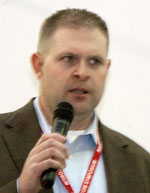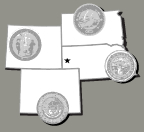Cutting Through the Myths to Feed a Growing Global Population
by Troy Smith for Angus Productions Inc.
MITCHELL, Neb. (Nov. 30, 2011) — Addressing cattle producers gathered for Range Beef Cow Symposium XXII in Mitchell, Neb., Travis Choat of Elanco Animal Health, said it is time to end the debate over technology’s role in food production. He shared a forecast by the United Nations Food and Agriculture Organization (FAO) regarding the food needed to nourish a world population expected to reach 9 billion by the middle of this century.
“By the year 2050, we will need 100% more food,” said Choat. “And the FAO says 70% of it must come from efficiency-enhancing technologies. It has to; we don’t have 100% more land to produce that food.”

Travis ChoatTo illustrate how hunger already is a growing concern, even in industrialized nations, Choat shared data indicating two in five children living in London, England; one in eight children in France; and one in five children in the United States are hungry because of an insecure food supply.
Choat cited data suggesting malnutrition may be the No. 1 health problem in developing nations. The reason may be that adequate food supplies are lacking or that the cost of food is too high. Technology offers solutions for both.
According to Choat, standing in the way is a myth claiming people don’t want modern technologies used in food production. As evidence to the contrary, he cited results of a recent International Consumer Attitudes Study revealing opinions and food-buying behaviors. Involving more than 97,000 consumers in 26 countries, the project looked not only at what people say they want, but how they spend their money.
Choat said the results suggest 95% of consumers make food purchase decisions based on taste, cost and nutrition, and in that order. Another 4% of food buyers make choices based on lifestyle. Collectively, explained Choat, they represent a 99% majority that does not base everyday purchase decisions on food safety concerns or political issues like animal rights. They are either neutral or support the use of efficiency-enhancing technologies to grow food. All want to exercise their right to choose.
“The other 1% of food buyers represents the radical fringe driven by emotion and myth. They want to protect us from ourselves and oppose the use of modern technologies to produce food,” said Choat. “But we can learn from the fringe 1%. They do take action.”
Choat urged his audience to also be proactive in exposing the myth and telling how technology supports three fundamental rights. The first is the right to food — to not go hungry because food is unavailable. The second right is choice — to be able to choose from a variety of food products. The third right is sustainability — to be “environmentally right” and protect natural resources while producing food for a growing world population.
Choat encouraged beef producers to make it personal and engage key food chain influencers about the need to provide for these rights, through implementation of innovative technologies.
“Morally, scientifically, economically, environmentally and socially, the data support the use of technology,” said Choat. “So support the 99%!”
To see the PowerPoint that accompanied Choat's presentation, click here.
The biennial Range Beef Cow Symposium was hosted Nov. 29-Dec. 1 at the Mitchell Events Center, Mitchell, Neb., by the cooperative extension and animal science departments of the University of Nebraska-Lincoln, South Dakota State University, Colorado State University and the University of Wyoming. Comprehensive coverage of the event is provided online at www.rangebeefcow.com, an event coverage site provided by Angus Productions Inc. (API), publisher of the Angus Journal and the Angus Beef Bulletin.
Editor’s Note: API's coverage of the event is made available for distribution to all media via an agreement with the Range Beef Cow Symposium Committee and API. Headquartered in Saint Joseph, Mo., API publishes the Angus Journal, the Angus Beef Bulletin, the Angus Beef Bulletin EXTRA, and the Angus e-List, as well as providing online coverage of events and topics pertinent to cattlemen through the API Virtual Library. For questions about this site, or to notifiy us of broken links, click here.

